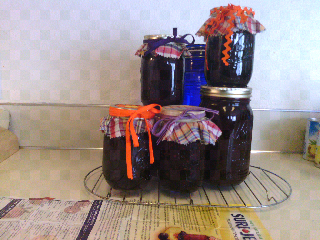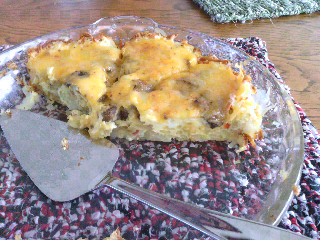BEST Homes and Gardens
Thursday, September 27, 2012
Thursday, June 28, 2012
Garlic Health Benefits
The garlic clove contains various nutrients as water soluble nutrients include vitamins, enzymes, amino acids and natural sugars & oil soluble nutrients includes sulphur compounds originating from an amino acid named alliin which is converted to a pungent compound called allicin which has natural antibiotic properties. Presence of sulphur in garlic is the cause of its pungent smell. However, the quality of Garlic cannot be over hidden due to this smell. In several scientific studies it has been found that:
Garlic Medicinal Uses
- Garlic acts as an antiseptic & helps in curing the wounds very quickly.
- One of the health benefits of garlic is that it helps in fighting against various infection & acts against inflammation and infection, including colds, coughs by adding a freshly cut raw clove to food three times a day or take kyolic garlic capsules but raw is always best.
- In certain studies in China it has been shown that it contains chemicals that prevent cancer. They suggest that eating garlic on regular basis provides some protection against cancer.
- Fresh or cooked garlic or 500 mg garlic capsules twice daily helps in lowers down the blood pressure & cardiovascular problems. It increases the levels of high density lipoproteins & reduces harmful cholesterol in the blood & keeps arteries and heart healthy.
- It thins the blood, reduces clotting and helps in controlling blood pressure and poor circulation.
- Garlic stimulates the immune system of body & helps in fighting against various diseases.
- Prevents & relieves chronic bronchitis, respiratory problems, and catarrh.
- It acts as a nasal decongestant & expectorant.
- It is also helpful for hum oral asthma, hysteria, dropsy & scurvy.
- Garlic works as a cleanser of the digestive system, helps in curing flatulence, kills internal parasites and is an excellent internal antiseptic.
- Researcher recommends daily dose of fresh garlic of about 4 gm, equivalent to one or two small cloves for each & every person who wants to keep himself healthy.
WHEATGRASS
- It boosts the hemoglobin production.
- Rebuilds the bloodstream.
- Helps in healing the wounds.
- Improves digestion.
- Cleans the liver.
- Purifies the blood in the entire body.
- Cut the grass ½ "above the soil surface with the help of a knife or scissors.
- If using the juicer then take out the juice as described in the juicer manual. In case you are using mortal and pestle, first chop the leaves and while adding little water at a time, grind it into a fine paste. Then using a clean muslin cloth, strain the juice in a cup. Again repeat the process using the same leaves till the grass turns white.
Homemade Indian Cuisine
Make sure to have the following in the kitchen:
Red chilli powder
Turmeric powder
Coriander powder
Garam masala powder
Whole garam masala (peppercorns, cloves, cinnamon, cumin seeds, cardamom)
Dried mango powder
Pav bhaji masala
Sambhar powder
Sunday, June 17, 2012
Cracking an Egg Underwater
Saturday, June 16, 2012
Limoncello
Limoncello (Italian pronunciation: [limonˈtʃɛllo]) is an Italian lemon liqueur mainly produced in Southern Italy, especially in the region around the Gulf of Naples, the Sorrentine Peninsula and the coast of Amalfi and islands of Procida, Ischia and Capri.[1] It is also produced in Sicily, Sardinia, Menton in France, and the Maltese island of Gozo. Though there is debate about the exact origin of the drink, it is at least one hundred years old.[2] [3]
Traditionally, it is made from the zest of Femminello St. Teresa lemons, that are also known as Sorrento lemons.[3][4] Lemon zest, or peels without the pith, are steeped in grain alcohol until the oil is released. The resulting yellow liquid is then mixed with simple syrup. Clarity and viscosity are affected by factors like the relative temperatures of the two liquids. Most lemons, including the more-common Eureka lemon will produce satisfactory limoncello.
Friday, June 15, 2012
Friday, June 8, 2012
What You Need
Cast iron skillet
Dish soap
Sponge or stiff brush
Clean, dry cloth or paper towels
Vegetable oil or shortening
Oven
Instructions
Saturday, October 29, 2011
CASHEW IN CASHEW OUT
Crab n cream cheese wonton w-SPRINGFIELD, MO CASHEW CHICKEN

Tuesday, September 13, 2011
10 Make-Ahead Breakfasts to Start Your Day Off Right
Do you ever feel that breakfast is the ultimate Catch-22? Without breakfast, we are not fully awake. But to prepare breakfast requires more than a dollop of alertness. Boiling water for poached eggs, hot butter for pancakes — the hazards! And the time — who has the time? And yet breakfast is a necessity. You are better for eating it. It fuels the brain and the body, and while anyone can pour milk and cereal into a bowl, you're even better off if you eat something with more substance, more staying power.
Let us help you. Bypass the morning Catch-22, and make your breakfast the night before. Here are 10 breakfasts that are especially good for making ahead of time — from homemade yogurt cups, to eggy muffins with herbs and prosciutto, to creamy steel-cut oats, made in the easiest possible way.
Read Full Post
Crockpot Bean Soup With Ham
Cook Time: 10 hours
Total Time: 10 hours
Ingredients:
- 1 meaty ham bone
- 2 cups Navy beans or mixed beans, washed, sorted, and soaked overnight
- 8 c. water (3 c. more may be added after bone is taken out, then cook some more)
- 1 clove garlic, minced (or 1/2 tsp. garlic powder)
- 1 bay leaf
- 1 lg. onion, chopped
- 1 tbsp. lemon juice
- 1 tbsp. honey
- Salt & pepper, to taste
Preparation:
Serves 6 to 8.
Tuesday, August 30, 2011
Kill Bugs With Diatomaceous Earth [Pest Control]
Diatomaceous Earth (DE) is a substance made up of the fossilzed remains of plankton; it looks like an off-white talc powder. It can kill any bug with an exoskeleton easily, but is safe for any mammal to eat. It is a popular way to kill bugs without using insecticide. More »
Source: Kill Bugs With Diatomaceous Earth [Pest Control]:
Liquid Gold
Logically, we should recycle our urine to capture its many nutrients for growing new food. Here’s a fuller case for that argument, and if you buy it, how to practically accomplish this export on the small scale of a homestead. Most likely you’ll be the only person in your neighborhood mining “liquid gold,” but you may also be an outlaw, two issues this book anticipates. The small book is also chock full of urine lore, including the historical medical, cooking (!), chemical, and agricultural roles urine has had. This small booklet changed my mind.
-- KK
Liquid Gold
Carol Steinfeld
2004 (2007), 95 pages
$11
Available from Amazon
Sample Excerpts:
Sample excerpts:
Hakan Jonsson fertilizes his lawn with a device he made that distributes urine evenly through perforated pipe while he dilutes it with a garden hose.
*
Urinals for women are not new, but the demand for these has been limited.
Lately, women's urinals have popped up at music festivals where disposable cardboard personal urine diverters, such as the P-Mate (below), are provided with which to use them.
The advantage: More service in a smaller space and shorter waits for portable toilets.
*
The largest ears of corn on the left were fed a 3:1 water-urine mixture three times a week. The others were fed far less.
*
According to sanitation researcher Caroline Schonning of the Swedish Institute of Infectious Disease Control, humans rarely excrete disease-causing organisms, orpathogens, in urine. Also, most pathogens die when they leave their hosts, either immediately or shortly thereafter. The only significant urine-transmitted diseases are leptospirosis (usually transmitted by infected animals), schistosoma, and salmonella. The first two are rare--usually found only in tropical aquatic environments--and the last is typically inactivated shortly after excretion. The more likely health risk is urine contaminated by feces that were misplaced in a urine-diverting toilet.
Second excerpt:
*
There are other ways to use liquid gold. For small amounts of urine, you can make a urine planter. Layer shredded cardboard or paper with chunky sand or peastone. Add more material when the contents shrink as the paper decomposes. Plant hearty nutrient-loving plants, shrubs, or small trees. Urine also works well in hydroponic planter systems.
Layer sand and peastone with shredded cardboard in a planter to create a urine planter. Over time, the mix will decompose into a soil.
*
Applying urine to leaves, not roots, is its most effective use, according to Paul William. "Foliar feeding is much more efficient at stimulating plant growth than fertilizing via the root system only," he says. "The leaves respond within hours of the application."
Paul William applies diluted urine to fruit trees.
To determine the best dilution to prevent the mis from getting too salty, he uses a TDS (total dissolved solids) meter available from hydroponic garden supply stores. "My tap water has 600 ppm (pars per million) as a result of the chlorine salts before I add any urine. I add urine until I get around 1,700 ppm." He also adds a bit of soap so the spray better penetrates the leaves.
"Urine foliar feeding is amazing," he says. "My friends are having huge success growing all kinds of tropical plants doing it, and my temperate plants are so lush and green, it boggles the mind!"
Source: Liquid Gold
Sunday, August 28, 2011
Wild Northwest Blackberry goodness
Blackberry jam and blackbery compote

Wednesday, August 24, 2011
Preserving the Season: Make Oven-Roasted Tomatoes!
Most of us don't have quite the right mix of constant sun, available square footage, and patience necessary to make true sun-dried tomatoes at home. But we can take a short-cut!
Read Full Post
Thursday, August 18, 2011
How To Avoid Buying Contaminated Honey Food Safety News
Do you know where your honey comes from? Food Safety News reports that as much as a third of honey (and likely more) sold in the United States has been imported from China. So what? Much of this imported honey has been banned in Europe and likely contains potentially harmful additives. How can you avoid it?
Read Full Post
Recipe: Summer Squash with Baked Eggs
It's that squash-y time of year, when gardens, CSA boxes, and market baskets overflow with zucchini, crooknecks, pattypans, and more. Whether you have one variety or three, here's a way to eat a bunch of squash – plus summer tomatoes, basil, and a handful of eggs – for breakfast, brunch, or dinner.
Read Full Post
Wednesday, August 17, 2011
Fizzy, Bubbly, & Fresh: 10 Recipes for Homemade Soda
Read Full Post
Monday, August 15, 2011
Fruits & Veggies Are Not as Nutritious as 60 Years Ago Grist
Did you know tomatoes had 55 percent more calcium and 25 percent more iron in 1950 than they did in 1999?
Grist wrote about a study that compared the nutrients found in fruits and vegetables grown in 1999 to those grown almost 50 years before. Breeding high-yielding crops, it seems, has led to a loss of nutrients in our produce.
Read Full Post
How to Make Your Own Hamburger Buns
I have to apologize. See, I got so excited about the idea of homemade hamburger buns that....well, I forgot the burger. When you make these, be sure you don't do that because these soft and oh-so-fluffy buns deserve to be crowned with some mighty fine burgers.
Read Full Post










